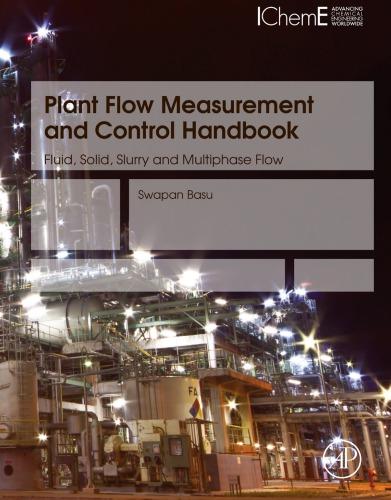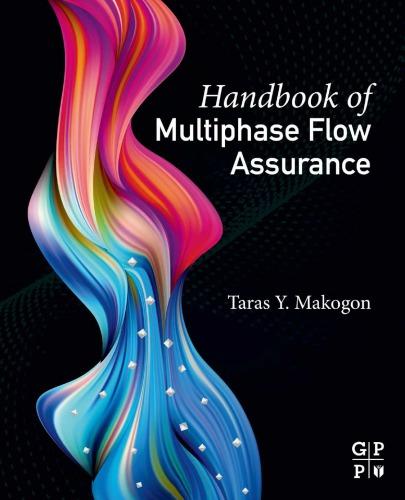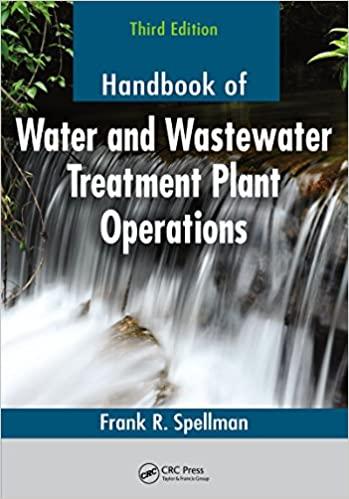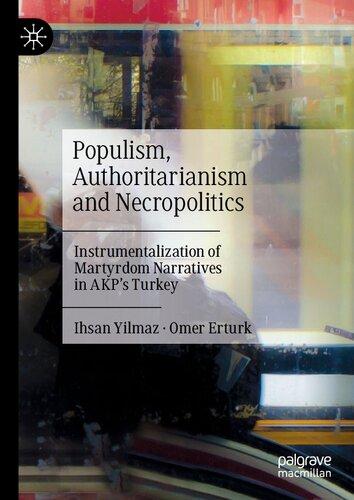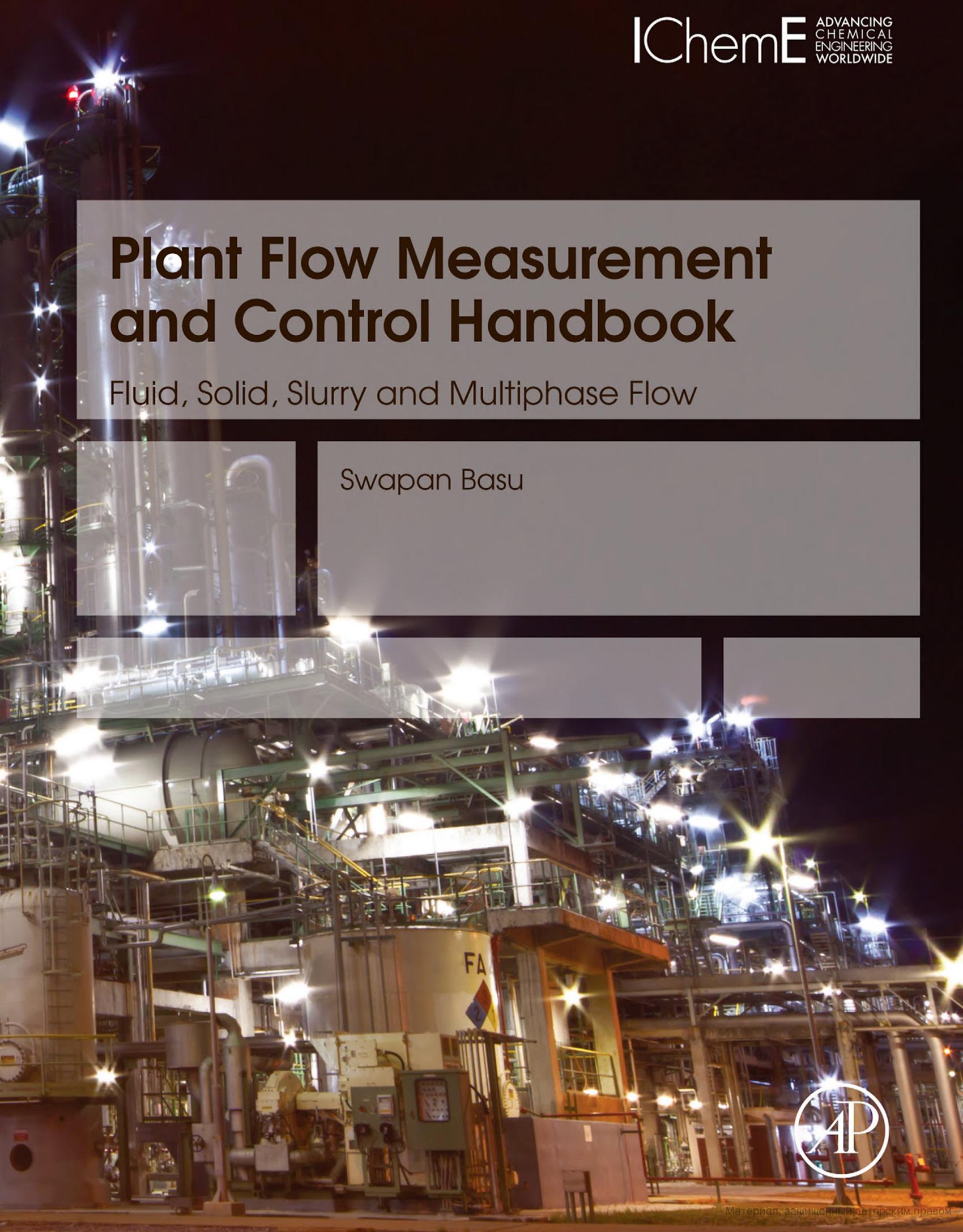PlantFlowMeasurementand ControlHandbook
Fluid,Solid,SlurryandMultiphaseFlow
SwapanBasu
AcademicPressisanimprintofElsevier 125LondonWall,LondonEC2Y5AS,UnitedKingdom 525BStreet,Suite1650,SanDiego,CA92101,UnitedStates 50HampshireStreet,5thFloor,Cambridge,MA02139,UnitedStates TheBoulevard,LangfordLane,Kidlington,OxfordOX51GB,UnitedKingdom
Copyright © 2019ElsevierInc.Allrightsreserved.
Nopartofthispublicationmaybereproducedortransmittedinanyformorbyanymeans,electronicormechanical,including photocopying,recording,oranyinformationstorageandretrievalsystem,withoutpermissioninwritingfromthepublisher. Detailsonhowtoseekpermission,furtherinformationaboutthePublisher’spermissionspoliciesandourarrangementswith organizationssuchastheCopyrightClearanceCenterandtheCopyrightLicensingAgency,canbefoundatourwebsite: www. elsevier.com/permissions
ThisbookandtheindividualcontributionscontainedinitareprotectedundercopyrightbythePublisher(otherthanasmaybe notedherein).
Notices
Knowledgeandbestpracticeinthis fieldareconstantlychanging.Asnewresearchandexperiencebroadenourunderstanding, changesinresearchmethods,professionalpractices,ormedicaltreatmentmaybecomenecessary.
Practitionersandresearchersmustalwaysrelyontheirownexperienceandknowledgeinevaluatingandusinganyinformation, methods,compounds,orexperimentsdescribedherein.Inusingsuchinformationormethodstheyshouldbemindfuloftheir ownsafetyandthesafetyofothers,includingpartiesforwhomtheyhaveaprofessionalresponsibility.
Tothefullestextentofthelaw,neitherthePublishernortheauthors,contributors,oreditors,assumeanyliabilityforanyinjury and/ordamagetopersonsorpropertyasamatterofproductsliability,negligenceorotherwise,orfromanyuseoroperationof anymethods,products,instructions,orideascontainedinthematerialherein.
LibraryofCongressCataloging-in-PublicationData
AcatalogrecordforthisbookisavailablefromtheLibraryofCongress
BritishLibraryCataloguing-in-PublicationData
AcataloguerecordforthisbookisavailablefromtheBritishLibrary
ISBN:978-0-12-812437-6
ForinformationonallAcademicPresspublicationsvisit ourwebsiteat https://www.elsevier.com/books-and-journals
Publisher: JonathanSimpson
AcquisitionEditor: KostasKIMarinakis
EditorialProjectManager: JoshuaBayliss
ProductionProjectManager: SuryaNarayananJayachandran
CoverDesigner: VictoriaPearson
TypesetbyTNQTechnologies
DedicatedtoGurudeb,whomItrust and tomyparentsandKakamoniand mylovingwifeandchildren
Foreword
Flowisapartoflife.Inoureverydaylife,itisdifficultto imagineaphysicalsystemwherethereisnoscopefor flow. Eventhesimplestofsystemsovertimerequiresomeform ofexchange,whichcanbeperceivedorrepresentedas flow.Measurementandcontrolofthe fl owrateofphysical materialsareextremelyimportantformassbalanceand economicreasonsandcanneverbeoverestimated.Given thewidevariationsofphysicalmediahavingavarietyof physicalandchemicalproperties,itisnaturalthattherewill beaneedfordedicated fl owmeterand/or fl ow-metering devicetypestosuitspecifi cneeds.Oneoftheunique featuresofthisbookisthatitcaterstoalltypesof flow: fluid,solid,slurry,andmultiphase;anddetailstreatiseon measurement,communication,andcontrols.Thebookin eachsectionisdedicatedtothedescription,speci fication, installation,calibration,andcustodytransfer(whereapplicable)ofdifferenttypesof fl owmeters, flowdevices, flow converters,alongwith fieldbuscommunication.The inclusionofmoderncommunicationssystems,applications ofthesemetersinsafeaswellashazardousconditions, safetylifecycleand flowmeters,aswellas fl owconverter enclosuredetailshavealsoenrichedthebook.
Althoughtherearebooksthathavecoveredtheseareas separately,therewasnosinglebooktocoverallthesetypes of flow-meteringdeviceswithrequireddetailsmentioned aboveinasinglevolume.Startingwithbasic flowmeasuringprinciplesitcoversheadtype flowmeters, openchannel flowmeasurement,PD flowmeters,velocity andforcetype flowmetering,mass flowmeters,slurry flow measurement,solid flowmeters,multiphase flowmeters, special fl owmeteringdevices(includingcryogenic flow
measurement), flowconditioningalongwiththeapplication ofdifferent flowmetersindifferentplantsovertwelve chaptersandsevenappendices.Ifeltthatthebookoffersa fi nebalancebetweenfundamentaldetails,theoretical analysiswithrequiredmathematicaldetailsandformula, andpracticalissuesrelatedtodesign,installations,and calibrationcustodytransfer(asapplicable).Thebookoffers detailedapplicationsnotonlytoplantsofdifferenttypes andsizesbutfor fl owmetersinotherapplicationsalso.
Theauthorofthismonumentalwork,Mr.SwapanBasu, hasarichindustrialexperienceininstrumentationand controlengineeringinIndiaandabroad,withmyriadprocessdesignandcommissioningexposurestohiscredit,and maintainsacontinuinginterestinthelatestdevelopmentsin his field.Itrulyfeelthatthebookwhichdeveloped,often drawingfromtheauthor’spersonalindustrialexperiences, wouldbeextremelyhelpfultopracticingengineersaswell asforfreshersinthe fi eld.Thisbookisextremelyhelpful forcivil,mechanical,andprocessengineersdealingwith fl owsystemsinplantsandprocesses.
Iamdelightedtoknowthatthisbookhasbeenselected by IChemE intheirseriesofpublications.
Iwishtheauthorallthesuccessforthebookfromhis efforts.
Dr.DipakC.PatranabisM.Sc.(Tech.),Ph.D.,M.I.E., F.I.E.T.E.,M.I.S.A. FormerProfessorandHead,Dept.Instrumentationand ElectronicsEngg. JadavpurUniversity Kolkata700092
Preface
Inourdailylifewealways flowinoneformortheother. Themostcommonformsof floware fl owofairand flowof water.Itisdif ficulttoimagineaphysicalprocessorsystem without flow.
Thephysicalandchemicalpropertiesofphysicalmedia havewidevariations,givingrisetodifferentkindsand typesof flows.Somemediamaybelighterorsomemaybe heavier,andsomemaybehighlyviscous,whilesomemay havehighturbulence.Inthecaseofsolid flowstherewill bevariationswithrespectto flowabilitydependingonthe bulkdensityandotherpropertiesofsolids.Dependingon therheologicalpropertiestherewillbevariationsinslurry flowmeasurements.Inthecaseofmultiphase flow, dependingonthefractionsofsolids,liquids,andgases, therewillbedifferencesin fl owmeasurementprinciples. Whilethemajorityof fl uid flowsareNewtonian,therewill besome flowswhicharenon-Newtonian.Inordertocater toalltheserequirementstherewillbedifferentkindsof flowmetersworkingondifferentmeasuringprinciplesand technologies.Thisbookcoversdesigndetails,sizingcalculations,specifi cation,installation,calibration,andapplicationnotesforeachofthe flowmetertypes.
InChapterI, flowmeasurementprinciplesalongwith thebasictechnologybehinddifferentkindsandtypesof flowmeterspertinentto fluid,solid,slurry,andspecial flows,alongwithmultiphase flowmeters,havebeendiscussed.Whilediscussingthis,adetailedaccountonthe basictheoryofmeasurementwithmathematicaldeductions & equations,andphysicalandmathematicaldetailsonthe mechanicsof fl owmeteringhavebeencovered.Special emphasishasalsobeenputonthemethodsofselectionof flowmeterswhichcancatertotherequirementsforvarious applications.Discussionshavebeenputforwardoncalibrationneedsandmethodsalso.ChapterIIhasbeen dedicatedtoheadtype fl owmeasurementandvariable-area flowmeters.Thediscussionsincludedifferentkindsof primary flowelements,alongwithdetaileddiscussionson fluidmechanics.Theprosandconsofvariousdifferential flowelementsalongwiththeirapplicationshavebeen covered.
Openchannel fl owmetering,withdetailsofhydraulic design,areusedformeasurementoflarge fl owsof water,suchasinrivers/dams.ChapterIII,dealingwith
open-channel fl owmeasurement,discussesindetail varioushydraulicstructuresmeantforopen-channel fl ow measurement.Detailscoveredhereincludesizingand designcalculationsforthesestructureswithdesignformulaandmeasuringmethods.Anumberofsensors coveringbothmechanicalaswellaselectronictypes,such asUStypes,havebeenincludedinthischapter.Awide rangeofPDmetersisavailableformeasurementsof different fl uidtypes,especiallyforhighlyviscous fl uids likethosefoundinoilandgasapplications.ChapterIV hasbeendedicatedtoPDmeterstocoveralmostalltypes ofPDmetersavailable,withtheirapplicationareas.
Velocityandforcearecommonlyusedparametersfor fl uid flowmeasurement.Turbinemeters,electromagnetic fl owmeters,ultrasonic flowmeters,vortex/swirlmetera, and fluidicmeters,suchasCoandaeffectmeters,areexamplesofvelocitytype flowmeterscoveredinChapterV, whichalsoincludestarget flowmetersbasedontheforcemeasuringprinciple.Apartfromvolumemeasurementsof fl uidsdiscussedabove,mass flowmeasurementbasedon Coriolisprinciplesandtwin-turbine flowmetershavebeen coveredinChapterVI.Thischapteralsodiscusseswhyand howmass flowmeasurementisaccurateandtrue fl ow measurementsfor fluids.
Rheologicalpropertiesof fl uidsactuallygovernslurry fl ow.Therearedifferenttechniques,suchaswedgemeters, alongwithspecialtypesofconventionalmetersredeployed forslurry fl owmeasurement.Some fluids,whicharenonNewtonian,needspecialattention.InChapterVIIthese havebeencovered.
Solid flowmeasurementandtheirrequirementsare quitedifferentfromthoseapplicablefor fl uid fl owmeasurement.ChapterVIIIhasbeendedicatedtoaccountfor thesame.Startingfromstandardweightmeasurements suchascentripetal,impactscale,weighfeeder,andbelt weigher,detaileddiscussionshavealsobeenpresentedon Coriolistype fl owmeasurement,gravity-fi llingmachines, roadvehicleweighing,andrailwayweighing.Also, noncontacttypemeasurements,suchasmicrowavetype fl owmetersandradiometric flowmetershavealsobeen described.
Multiphase flowisquitecommonlyencounteredinoil andgas fields,andmanyotherareasdemandcompletely
differentkindsofmeasurementtechniques.Thereisawide rangeoftechnologiesinvolvedinthemeasurementof multiphase flowmeasurement,theseare:gammaray,PIV, LDAEIT(includingvirtualmeasuringsystems),tomographytypesincludinggamma/X-ray,neutron/positron,optical,ultrasonicelectricalimpedancewithcomputerized tomography(CT),tonameafew.Detailedaccountsof these,alongwithconventionalmeasurementtypes,and theirapplicationsdependingonmultiphase fluidconditions havebeenenumeratedatlengthinChapterIX.
ChapterXisdedicatedtovarious flowsensingtypes, flowgages, flowswitches(forsolid flowalso)types,along withstandardmechanicalmeters,suchaswatermeters. Detaileddiscussionshavebeenpresentedoncryogenic flowmeasurementandvariouskindsof flowpickupsused in flowmeters.
Flow-conditioningdevicesarebasicallyaccessoriesfor flowmeasurementusedforaccurate fluid flowmeasurements.DPTsandMVTsaremajordevicesfor flow measurementwithheadtype flowmeasurement.Various flow-computingdevices,controllers,batchcontrollers,and dispensersareusedin flowmeasurementsystemsassecondarydevices.InChapterXI,discussionsonthese,along
withenergy fl owmeteringandmeteringpumpshavebeen includedtocompletethediscussionson flowmeasurement systems.
Detaileddiscussionson flowmeasurementproblems andplant-specificissuesinvariouspower,process,and industrialplantshavebeendiscussedinChapterXII.
Engineeringunitconversions,materialselections,and mechanicaldetailsof flowmetersandtheiraccessoriesare veryimportantfor flowmeterapplications.Allthese requireddataanddesigndetailshavebeenappendedtothis book.Theimportanceofsafetylifecycle,hazardous applications,andenclosuredetailsfor fl owmeasurement cannotbeoverestimated,sorequireddetailshavebeen appendedtothisbookalongwithdiscussionsondevice communications.
Anattempthasbeenmadetomaintainthedelicate balancebetweentheoreticalandmathematicaldetailsand theauthor’sresearchworkonthesubjectsthroughglobal industrialplantexperiencesovernearlyfourdecades.The effortsoftheauthormakethebooksuitableforpracticing engineersinindustriesaswellasforbuddingengineersand advancedstudents.
CHAPTERI
FLOWMETERING:GENERALDISCUSSIONS(ANOVERVIEW)
ChapterOutline
1.0.0Introduction1
1.0.1DiscussionsCoveredinThisBook3
1.0.2InternationalStandardsandRegulations5
1.1.0FlowMeasurementBasics5
1.2.0GeneralRelevantTermsandDiscussions19
2.0.0BasicFluidMechanics31
2.1.0Bernoulli’sEquationforPipeFlowMeasurement34
3.0.0FlowMeasurementTypesandPrinciples42
3.1.0FluidFlowMeasurementTypesandPrinciples43
3.2.0SolidFlowMeasurementTypesandPrinciples83
3.3.0SlurryFlowMeasurementTypesandPrinciples97
3.4.0MultiphaseFlowMeasurementTypes andPrinciples99
4.0.0SelectionofFlowMeters109
4.1.0GeneralDiscussionsontheFlowMeterSelection Process(ClosedPipe)111
4.2.0SpecificDiscussionsontheFlowMeterSelection Process(ClosedPipe)113
4.3.0OpenSystemFlowMeterSelection121
4.4.0CostandApprovalConsiderationsforFlow MeterSelection121
4.5.0FlowMeterSelectionMatrix122
1.0.0INTRODUCTION
Istillremembertheinterviewdayofmy firstjob,I wasaskedbyoneoftheinterviewers, “Whatare themajorparametersmeasuredforboilermonitoring?” Asafreshengineerandwithoutthinking throughthequestion,Iimmediatelyreplied “steam flow” (probablyasitwasaboiler,steamcameinto mymind).Oneoftheinterviewers(probably)was surprised!Hestaredatmeandasked “Howcome youthoughtofsteam flow first?” Thenitwasmy turntobesurprisedwiththecounter-question.I reallyhadnoanswer!HopefullyIcouldguess now,aftersomanyyearsintheprocessindustry, whytherewasacounter-question.Ofthefour majorparameters,i.e.,pressure,temperature, level,and flow,normallymeasuredinallprocess
5.0.0DiscussionsonPermanentPressureLossand AlliedIssues125
6.0.0PrinciplesandGoodPracticesofInstallationand Calibration127
6.1.0PrinciplesandGoodPracticesfor Installations127
6.2.0PrinciplesandGoodPracticesfor Calibrations130
7.0.0CriticalorSonicNozzle134
7.1.0FeaturesandAdvantagesofSonicFlow Nozzles135
7.2.0ApplicationsofSonicFlowNozzles135
7.3.0FunctionalDetailsofSonic FlowNozzles135
8.0.0MiscellaneousFlowMeasurementSystems136
8.1.0AerofoilinAir/GasFlowMeasurement136
8.2.0BritishThermalUnitMeasurement137
8.3.0Cross-CorrelationFlowMeasurement140 ListofAbbreviations144 References145 FurtherReading148
controlinstrumentation, flowmeasurementisthe mostcomplex,asthereisnodirectmeansto measureit.For flowmeasurementonehasto dependononeorotheroftherelatedparameters, whichvarywiththeassociatedconditions.The historicalbackgroundof flowmeasurementhas beenillustratedin Fig.I/1.0.0-1.
Fromelementaryphysicsitisknownthatthere arethreestatesofmatter.Theseincludethe following.
l Solids: Themoleculesofa solid areusually closertogetherandtheattractiveforcesbetweenthemoleculesofasolidaresolarge thatasolidtendstoretainitsshape.
Fluids: Inthecaseof fluids,theattractive forcesbetweenthemoleculesarecomparatively
The concept and understanding of “FLOW” comes after the publication of “Hydrodynamica” in 1738 by the Swiss physicist and mathematician Daniel Bernoulli (17001782). He actually framed famous fluid equation. However earlier days also people had some concept of flow, Aristotle viewed the motion which involves a medium that rushes in behind a body to prevent a vacuum. Bernoulli introduced the concept of the conservation of energy for fluid flows. So when a restriction is put, there will be increase in fluid velocity hence kinetic energy but there will be loss in static pressure, hence energy.
FIGUREI/1.0.0-1 Historicalbackgroundoftheconceptof fluid flow.
muchsmalleranddonotretaintheirshapes.A fluidmaybeeithera gas ora liquid.
l Gas: Themoleculesofagasaremuchfarther apartthanthoseofaliquidandtheforceofattractionisweak.Forthisreasonagasisvery compressible,meaningthatuponremovalofall externalpressure,ittendstoexpandindefinitely.
l Liquid: Aliquidhasmoleculescloserthana gasandtheforceofattractionisgreaterthan inagas.Aliquidisrelativelyincompressible meaningthatuponremovalofallexternalpressureexceptitsownvaporpressure,theliquid doesnotexpandindefinitely.
Vapor: Avaporisagaswhosetemperature andpressurearesuchthatitisveryneartheliquid phase.Thussteamisconsideredavaporbecause itsstateisnormallynotfarfromthatofwater.
Naturally, flowmeasurementofeachofthese phasesandmixingofthemrequirestechnical approacheswhichshallbedealtwithindetailin thishandbook.
Againofthe fluid flowmeasurements, compressible fluid flowmeasurementiscomparativelymorecomplexthanfornoncompressive fluid/liquid.Similarly, flowmeasurementof multiphaseandslurryismuchmorecomplex. AccordingtoB.G.Liptak “Noindustrialmeasurementismoreimportantthantheaccurate detectionofthe flowrates.. ” Naturallythe followingquestioncomestomind “Why?” On accountofthefollowingreasons,theimportance of flowmeasurementinindustrialaswellassocial applicationshasgrownexponentially:
l accountingpurposesandleakage management;
l custodytransferfromsuppliertoconsumer (especiallyintheoilandenergysectors);
l essentialinanyprocessandmanufacturing plant,includingqualitymanagementinbatch processes,dosing,etc.
Asaresult,effortshavebeenmadetoimprove thequalityandperformancerequirementsfrom flow-meteringdevicesdemandinghigherorbetter accuracy,linearity(asapplicable),andabetter turndownratio.Thesafetylifecycleisnow becomingapartofanydevicesorsystemsleading todemandsforhigherstability,reliability,and safetyonthese fl owdevices.Also,inorderto matchwiththedevelopmentofelectronics (especiallyembeddedelectronicsandmicro controllers)andcommunications,additionaldemandshavebeenplacedon flowdevicestosupportsoftwareandcommunicationfacilities. Variouspointsdiscussedsofarafewexamplesof genericissues,inspeci fictherecouldbewide variationsinthe fluidpropertiesbetweentwo measurements(eveninthesameplant,e.g.,air flow,coal flow,steam flow,andfeedwater flowin powerplants)eveninthesameplantand/orin variousindustries.Thematerialmaybesolid, liquid,orgasandsingleormultiphase.Thematerialmaybeabrasive,corrosive,explosive/ flammable,ortoxic,etc.The flowcouldbeinan openchannelorinaclosedpipeoraduct.There canbelargevariationsinthesize(andgeometry) ofthepipe/ductorchannel(e.g.,afewmmtoa fewmeters).Therecanalsobewidevariationsin pressure(fromavacuumtoafewhundredkg/cm2) andtemperature(cryogenictoafewhundred degreesCelsius).Some fluidsmaybeconductive (water)andsomeareverymuchlessconductive (oil).Insomecasesvolumetric flowmeasurementsareacceptable,e.g.,ingasfuelstations a car fillingXlitersofpetrolorinirrigationXXX
cusecofwaterrelease.Ontheotherhand,inafew casesitisnecessarythat flowmeasurementsarein mass,e.g.,XXXtonsofcoalperXXXMWH energy,orXXXtonsofgypsumperXXXtonsof cementproduction.Fromtheabovediscussionsit isevidentthatmeasuringinstrumentsneedtohave atleastthefollowingqualities [1]:
l highoverallaccuracy;
l well-understoodfunctionality;
l betterdesignandeasysizing;
l establishedinstallationprocedurewithlessdependencyonpipestraightrun;
l easyoperationandmaintenance;
l testabilityevenwithoutatestbench;
l self-monitoringanddiagnostics;
l suitablydevelopedforsafetylifecycle;
l communicationability.
Inordertocatertotheserequirementsthereare quiteagoodnumberoftechnologiesthathave beendevelopedandareavailablefor flowmeasurements.Therefore,thetaskofthedesignerin selectinga flowmeterforaparticularserviceis becomingmoreandmorecomplex.Thisisclear fromasimpleexample:Steam flowmeasurement, withwhichthediscussionsstarted,canbe measuredbyheadtype flowmeasurementtechnique,vortexmeter,turbinemeter,orCoriolis mass flowmeter,tonameafewoftheseven technologiesusedforsteam flowmeasurement. Thequestioniswhichonewillbebestsuitedforan application.Evenwithinheadtypemeasurement therearechoicesof flowelements,suchorifice plate, flownozzle,etc.Therefore,itisextremely importanttoseewhichisbestsuitedforaparticular applicationaswellasbeingeconomical.Overview discussionshavebeenputforwardinthisbookto guideproperselectionof flow-measuring, computing,andcontrollingdevices.Emphasishas beenputtolookintothesizing,designcalibration, andinstallationaspectsofeachtypeof flowdevice. Also,shortdiscussionshavebeenputforwardto covercommissioningandoperationandmaintenance(O&M)ofthese flowdevices.Other importantissuesinconnectionwith flowmeasurementsarevariousinternationalstandardsand unitsandunitconversions.Inordertounderstand theimplicationsofthesestandardsin flowmeasurementsitisessentialtohavesomefundamental
knowledgeof fluidmechanicsandphysics.Inthis bookshortdiscussionsonthesearegiven.
1.0.1DISCUSSIONSCOVEREDIN THISBOOK
Priortomovingtotechnicaldetailsdiscussionsin thisbookhavebeenarrangedtoensurethatthe readeriswellawareofdetailedcontentofthebook.
1. ChapterI:Thischaptergivesinitialdiscussionstoportrayanoverviewofbasicmaterialcharacteristicpropertiesand flow meteringtechnology.Thecoverageincludes relevantparametersingeneralthataffect flowmeasurement, fluidmechanics,and physics,and flowprofile laminar flowturbulent flow.Anoverviewisprovidedof various flow-measuringprinciples,with shortdiscussionsontheprosandcons. Typesof flowmetersandtheirapplications forselection,requirementsforgoodpractices ofcalibration,andinstallationsarethemain issuesdiscussedhere.Thediscussionscover both fluidandsolid flowmeasurementsand controlsincludingslurry/complex fluidand multiphase flowsalso.Majorterminologies andcommonissuesmostlyhavebeen coveredinthischaptersoastohelptogo throughsubsequentchapters.
2. ChapterII:Headtype flow-measuring flow elementscoveringBernoulli’stheoremand flowcalculations.Alsocoveredarespeci ficationsheets,sizing,constructionaldetails, straightlengthrequirements,pressureloss, etc.fororificeplates, flownozzles,Venturi tubes,Dalltubes,Pitottubes,Annubar, Krell’sorifice,Vconeandelbowtype flow measurement.Wedge flowdevicealthough operateininheadtypemeasurementprinciplesyetasitismoreconnectedwithslurry flowmeasurementitisdiscussedinchapter VII.Althoughvariablearea flowmetering doesnotworkinheadtype flowmeasurement principlesyetsamehasbeencoveredhere.
3. ChapterIII:Openchannel flowmeasurement: Designandsizingofweirs,Parshall flumes, otheropenchannel flowmeteringelements andlevel-sensinginstruments.Designdrawing
specifications,installation,andcalibrationof theabovedevicesandelements.
4. ChapterIV:Positivedisplacementinstruments:Workingprinciples,prosandcons, designdetails,specifications,calibration, installationdetails,pressureloss,andtips forOperationandmaintenance(O&M)for positivedisplacement(PD) flowmeters suchasnutatingdiscs,ovalgear,rotating pistons,rotatingvanes,reciprocatingtype, helicalgearbi/trirotors,etc.tonameafew.
5. ChapterV:Force/velocitytypemeasurement: Workingprinciples,prosandcons,design details,specifications,calibration,installation details,andtipsforO&Mforeachofthe metersincluding:turbines,paddlewheels, vortices,electromagnetic,target,Coanda effectandmomentumexchange,andultrasonic(transittime,Doppler).Thischapter alsoaccountsforsomesensingtypes. Althoughnotvelocitytype flowmeasurement butthischapterincludesdiscussionson Targettype flowmeteralso.
6. ChapterVI:Generaldiscussionsonvolumetricversusmass flow,anddensityissues. Workingprinciples,prosandcons,design details,specifications,calibration,installation details,pressureloss,andtipsforO&M forCoriolisandothermechanicalmass flow metersaswellasthermalmass flowmeters.
7. ChapterVII:Thischapterhasbeendedicated forslurryandcomplex fluid flowmeasurements.RheologyNewtonianandnonNewtonian fluidtypesandassociated fluid mechanicshavealsobeencovered.Itcovers bothvarious flowmetersandtheirapplicationsinindustriesaswellasvariousplant applicationsanduseof flowmetersthere havebeencoveredhere.
8. ChapterVIII:Solid flowmeasurement:Generaldiscussionsandsolid flow-measuring techniquesandassociatedphysics.Working principles,prosandcons,designdetails,specifications,calibration,installationdetails,and tipsforO&Mforeachofthemetersincluding: CoriolissolidFM,microwaveandnucleonic solid flowmeters,loadcellsandspeedsensors, impactscale,lossinweightandgravity feed,beltscale/beltweigher,weighfeeder.
DiscussiononGaininweight(GIW)and Lossinweight(LIW)havealsobeencovered soastomeettherequirementsforvarious fillinganddispensingmachinesdiscussedin chapterXI.
9. ChapterIX:Multiphase flowmeasurement: Multiphase fl ow-measuringconcept,twophase fl owmeasurement,wetgas fl owmeasurement,miscellaneous fl ow-measuring techniques,multiphase fl owmeasurement withspecialreferencetooilandgasapplications.Ineachcaseworkingprinciples,pros andcons,designdetails,speci fi cations, calibration,installationdetails,andtipsfor O&Marecovered.Thischaptercovers detailedonvariousmeasurementtechnologiessuchasvarioustomographyprinciples tonameafew usedin fl owmeasurements ofmultiphase flowmeasurements,welltesting separatorsetc.
10. ChapterX:Special flowmeters, flowgages, andswitches:Workingprinciples,prosand cons,designdetails,specifications,calibration,installationdetails,andtipsforO&M forHalleffect flowmeters, flowmetersin cryogenicapplications,differentmetering pumpsandspecial flowinstruments.
11. ChapterXI:Flowcomputationandcontrol: Thischapterisdedicatedtovarious flowcomputingdevicesfromDPTstoMVTs. Thisalsoincludesmeteringpumps,energy calculators,dispensingmachines,batchcontrollers,bottlingmachines,batchcontrollers, flowcomputers(densitycompensation, flow managementcomputer), flowcontrollers (alarm,ON,OFF,andPID),signalconditioningunit,PLC/DCSinterface,rate flowindicator,aswellastotalizer.Foreachcaseadetailed description,specifications,designdata,electricalconnections,andinterfacearegiven.
12. ChapterXII:Plantapplicationandproblems: Thischapterisdedicatedtogeneralcommon problemsforvariousplantsandplantspecificissuespertinenttothermalpower plants,nuclearpowerplants,oilandgasindustries(offshore/upstream,midstream,and downstream),paperandchemicalplants, foodandpharmaceuticalplants,steeland metallurgicalplants,cementplantsetc.
13. AppendixI:Unitconversionsand flow regimes.
14. AppendixII:Materialselectionguide.
15. AppendixIII:Mechanicalandpipingdata.
16. AppendixIV:Custodytransfer.
17. AppendixV:Safetylifecyclediscussion.
18. AppendixVI:Enclosureelectricalprotection (class).
19. AppendixVII:Devicecommunication.
1.0.2INTERNATIONALSTANDARDS ANDREGULATIONS
Thereareanumberofinternationalstandards followedin flowmeasurements.Ashortlistof thesestandardsispresentedin TableI/1.0.2-1 for thereadertogothroughasrequired.Duringthe discussionsinthisbookthesewillbereferredto withthecorrectstandardreference.Thereaderis advisedtorefertothelatestrevisionofthe applicablestandard.
1.1.0FlowMeasurementBasics
Asindicatedin Fig.I/1.0.0-1,Itwasphysicist D.Bernoulliwho firstintroducedtheconceptof conservationofenergyin fluid flow.Fromfundamentalsofenergyconservationitisknownthat energyassociatedwithanygivenamount(mass) ofmaterialundergivenconditionsis fixed.Fluid mechanicsdiscussedhereisconcernedwiththe transformationofpressureenergyintovelocity andconverselyconversionofvelocitybackto pressureenergy.Herepressureenergymeansthe pressurewhichiscapableofcreatingbothkinetic energy(KE)andpotentialenergy(PE) [2].When anyrestrictionisputinaclosedpipelinethevelocityofthe flowingliquidincreases,becausethe volumeintheupstreamsidemustbeequaltothe volumeatthedownstream,otherwisetherewill beanaccumulationordearthofliquid!However, thisisnevernoticed.Onaccountofrestriction, theareadecreases,sotheremustbea
TABLEI/1.0.2-1 SomeRelevantInternationalStandardDetails* StandardNo.ApplicationArea
ANSI/ISA84.00.01SeeIEC61511(modified)
ANSI/ISA88Batchcontrol
ASME19.5Flowmeasurement performancetestcode
ASMEPTC6Flownozzle
DIN19559Measurementofflowofwastewaterinopenchannelsandgravityconduits
EN29104Methodsofevaluatingtheperformanceofelectromagneticflowmetersforliquids
EN60529Specificationfordegreesofprotectionprovidedbyenclosures(IPcode)
EN/IEC60529Specificationfordegreesofprotectionprovidedbyenclosures(IPcode)
EN/IEC60079Explosiveatmosphere
IEC61158Internationalcommunicationnetwork
IEC61508Functionalsafetyofelectrical/electronic/programmableelectronicsafety-related systems suppliercommunity
IEC61511Functionalsafetyofelectrical/electronic/programmableelectronicsafety-related systems processplantenduser
ISARP31.1Turbineflowmeter
ISO10790Measurementoffluidflowinclosedconduits Coriolisflowmeter
ISO11605Calibrationofvariable-areaflowmeters
ISO14511Measurementoffluidflowinclosedconduits. Thermalmassflowmeter
ISO15769Hydrometry acousticvelocitymetersusingtheDopplerandechocorrelation
TABLEI/1.0.2-1 SomeRelevantInternationalStandardDetails* cont’d
StandardNo.ApplicationArea
ISO2714Liquidhydrocarbons Volumetricmeasurementbydisplacementmeter.
ISO2715Liquidhydrocarbons Volumetricmeasurementbyturbinemetersystems
ISO31000Riskmanagementprinciplesandguidelines
ISO31010Riskmanagement Riskassessmenttechniques
ISO4359Flowmeasurementstructure Flumes
ISO4360Hydrometryopen-channelflowmeasurementusingtriangularweir
ISO51671Measurementoffluidflowbymeansofpressuredifferentialdevices
Generalprinciplesandrequirements
ISO51672Measurementoffluidflowbymeansofpressuredifferentialdevices Orificeplate
ISO51673Measurementoffluidflowbymeansofpressuredifferentialdevices Nozzleandventurenozzle
ISO51674Measurementoffluidflowbymeansofpressuredifferentialdevices Venturitube
ISO6416Ultrasonicflowmeasurement
ISO6817Measurementofconductiveliquidflowinclosedconduits
ISO6817Measurementoffluidflowinclosedconduits methodusingelectromagnetic flowmeter
ISO9104Measurementoffluidflowinclosedconduits
ISO9300MeasurementofgasflowbymeansofcriticalflowVenturinozzles
ISO/TR12764Measurementoffluidflowinclosedconduits vortexsheddingflowmeter insertedcircularcross-sectionconduitrunningfull
ISO11001Liquidflowinopenchannel
NEMAForenclosureclass
NORSOKI105Fiscalmeasurementsystemsforhydrocarbonliquid
Beforemovingtotechnicaldiscussionsitisadvisablethatforanydoubtonunitconversionsstandardbooksonunitsandmeasurements inanystandardphysicsbook(graduationlevel)maybeconsultedtoavoidanyconfusion. *Notexacttitlementionedhere.
correspondingincreaseinvelocity,sothatthe volume flowratematches.Againanincreasein downstreamvelocitymeanstherewillbesome acceleration.FromNewton’ssecondlawitis knownthatforanyaccelerationtheremustbe someimpressedforcewhich,inthiscase,comes fromhigherpressureattheupstream.Anincrease invelocitydownstreammeansthatdownstream fluidwillhavehigherkineticenergy.Froma conservationofenergypointofview,theremust
beacorrespondingreductioninenergyinanother form,whichhasbeentransformedintokinetic energy.Thistransformationcomesfrompressure energy.Therefore,downstreamthereisincreased velocityofliquid,i.e.,higherkineticenergyatthe costofadecreaseinpressure,i.e.,pressureenergy.Fromthediscussions,itisclearthata flow restrictioncausesanincreaseinthe flowingvelocityatthecostofpressureofthe flowing fluid asshownin FigI/1.1.0-1.
UPSTREAM SIDE TAPPING DISTANCES FROM A (PROVIDED IN TABLE BELOW) IN TABLE (PROVIDED IN TABLE BELOW) IN TABLE
0.35-085D 0 35-085D
dp Vena contracta Vena contracta
DOWNSTREAM SIDE TAPPING DISTANCES FROM A
NOT IN SCALE
UNSTABLE REGION
VENA CONTRACTA
dp PERMANENT PERMANENT
NOTE: IN THE TABLE BELOW ALL DISTANCES ARE MEASURED FROM UPSTREAM FACE OF FLOW ELEMENT (A).
NOTE: IN THE TABLE BELOW ALL DISTANCES ARE MEASURED FROM UPSTREAM FACE OF FLOW ELEMENT (A)
TAPPING UPSTREAM DOWNSTREM REMARKS TAPPING STYLE DISTANCE DISTANCE SYMBOL
C CORNER TAP
APPLICABLE FOR D < 50mm < F FLANGE TAP
APPLICABLE FOR D > 50mm >
D D/2 D TAP APPLICABLE FOR D > 150mm D > D D/2 P PIPE TAP 2.5D 2 5D 8
FIGUREI/1.1.0-1 Conceptof fluid flowmeasurement.
Asshowninthis figurethehighestpressure dropwillbeslightlyawayinthedownstream side.Thispointwherethepressuredropisthe maximumisreferredtoasthevenacontracta. PressureatthevenacontractaisPvc.Inheadtype flowmeasurementsthedifferentialpressurebetweenupstreamanddownstreamoftherestriction ismeasuredtocompute flow(discussedatlength insubsequentchapters).Afewtypicaltapping styleshavebeendepictedin Fig.I/1.1.0-1.When downstreamtappingisplacedatthevenacontractaitisknownasvenacontractatapping. Comingbacktothemainissue,from Fig.I/1.1.0-1 itcanbeseenthatafterhavingthehighestpressure atthevenacontracta,therewillbepressurerecovery.However,itneverreachestheoriginal upstreampressure.Thismeansthattherewillbe some permanentpressureloss(PPL).Thispermanentpressurelossthroughvarious flowelementscanbeexpressedasapercentageofthetotal pressuredrop.Priortoproceedingfurtherpreliminariesoftypicalcharacteristicsexpectedof flowmetersandthebasicsofafewotherdetails normallyencounteredin flowmeasurementsare discussed.Thiswillhelptograspthedetailsin subsequentchaptersfor flowmeasurements.
1.1.1BASICCHARACTERISTICSAND ASSOCIATEDTERMSFORFLOWMETERS
Thereareafewbasicdesirablecharacteristicsof flowmeteringdevices.However,thisdoesnot meanthatallthesecharacteristicsneedtobe
presentinall flowmeteringdevices.Someofthe mostimportantcharacteristicsarelistedbelow.
1. Wideoperating flowrange,temperature,and viscosity;
2. Lesssensitivitytoward flowprofileand relatedproperties;
3. Smallerpermanentpressureloss;
4. Suitabilityforawiderangeofmedia(material, fluid);
5. Suitableconstructionmaterialtowithstand corrosiveandabrasivedamage;
6. Simplercalibration;
7. Easyinstallation;
8. Lessmaintenance;
9. Immunitytovibrationandothermechanical disturbances;
10. Highersensitivity,reliability,andoverall accuracy;
11. Suitablesafetylifecyclestudy;
12. Safetyissuesandsafetyintegritylevel(SIL) asrequired;
13. Suitableoutputanddevicecommunication capability;
14. Suitableoutputsignalforeasyintegration. Inviewoftheaboveitisclearthatthereneed tobejudiciousapplicationsborneinmindwhile selectinga flowmeterforaparticularapplication. Thesewillbediscussedatlengthin Section6.0.0 ofthischapter.Abriefideaofthemeasurement accuracy(see Subsection1.1.2.1)ofafew flow metertypesisillustratedin TableI/1.1.1-1[3,4].
TABLEI/1.1.1-1 FlowMeasurement/Meters(TypicalforIdeaOnly) MeterNameAccuracy%FSDMeterNameAccuracy%FSD Orificeplate2Flownozzle1.5 Venturi1Pitottube0.5 Ultrasonicflowmeter1Electromagnetic0.5 Vortex1Cross-correlation1 Rotameter1(ofreading)Hotwire2 Positivedisplacement0.1(TD70:1)Turbine0.1(forTD100:1) Massflow0.1(TD100:1)Openchannel2% FSD,fullspandivision; TD,turndown(ratio);highestpossibleaccuracy.
1.1.2PHYSICSONFLUIDPROPERTIES
Fluidpropertiesshallbediscussedhere.For basics & explanationstandardbookonthermodynamicsshouldbereferenced.Densityandviscosityaretwo fluidpropertieswhichdirectly influence fluid flow.Densityismoreimportant whenmass flowcomputationisdesired.Also, bothdensityandviscosityinfluenceReynolds number(discussedlater)whichdetermines flow types,e.g.,laminar/turbulent flow.Whileonthe subject,itisbetter firsttodefine whatdensityis. The density r ofa fluidisits mass perunitvolume,i.e.,m/V ¼ r.Thereisanotherimportant termhere,specificweight,whichisdefinedbelow. Specificweight Y ofa fluidistheweightperunit volume,i.e.,specificweightgrepresentstheforce exertedbygravityonaunitvolume.So,densityand specificweightarerelatedby Y ¼ 1$r$gor Y [ rg,wheregisaccelerationduetogravity.The mostimportant fluidpropertyisviscosity.
1. Physicalsignificanceofviscosityandvelocityprofile: Theviscosityofa fluidputsresistancetothe flow,orresistancetoanyobject passingthroughthe fluid.Itcanbeconceived ofasthethicknessofthe fluid.Certain fluids, likewaterandgasoline, flowrapidlywhen
comparedwiththe flowofhoneyormotor oil.Sincehoneyormotoroilarethicker, theydonot flowrapidly.Onemustremember thatthisisnotduetodensityasoilsalower densethanwaterbut flowsslowly.Thisis duetoviscosity.Thismeansthatthicker fluids likehoney/motoroilhavemoreviscosity.Fluid flowmaybeconsideredasa collection of movingplates,oneontopoftheother,when aforceisappliedtothe fluid, shearing occurs andtheviscosityisa measureoftheresistance offeredbyalayerbetweenadjacentplates [5].
Thisislikeslidingthesemovingplatesrelativetooneanother,withthecenterplatemovingfastestandtheoutermostoneatrest.The viscousforcebetweenthetwoplatesopposes sliding.Thisisthereasonthatitisalso referredtoasinternalfriction.Thelayerof fluidnearthesurfaceisnearlyatrestwith respecttothesurface,whereasthespeedof the fluidlayeratthecenterwillbethehighest, asshownin Fig.I/1.1.2-1 Also,thereisno slippingatthecenter. Suchslipsoccurdue toviscosity.Thusitisseenthatviscosityhas animpactonthevelocitypro fileandhence flowmeasurement.
FIGUREI/1.1.2-1 Velocityprofileofviscous fluidinsideapipe.
Anotherimportantissueobviouslycomes intomindthatifthevelocityvariesfromthe walltothecenter,whichvelocityshouldbe consideredfor flowcalculation. Itisnormally theaveragevelocitythatistakenfor flow calculations.
Therefore,inordertokeepthe flowsgoing oneneedstoapplygreaterpressureattheback ofthe flowthanatthefrontofthe flow,e.g., aswhensqueezingtoothpasteoraketchup sachet [2].Inaliquid,thecohesiveforcesbetweenthemoleculesgiverisetoviscousforce. Inthecaseofcompressive fluids,e.g.,gas,it comesfromcollisionsbetweenthemolecules.
Fromtheabovediscussionsitfollowsthat layersmoverelativetoeachother.Thevelocityatwhichthelayersmoverelativetoeach otheristhereforetheshearrate.Shearrateis proportionaltoshearstress:
ShearratefShearstressorShearstress
¼ m$Shearrate.
Thisproportionalityconstantisreferredto as absoluteordynamicviscosity . Itisimportanttonotethatthediscussioninthecaseof Newtonian fluid(referto Subsection1.1.2.5 inthischapter)viscosityisindependentof shearrate. Herediscussionsarepresented onlyonNewtonian fluids.Furthergeneralized detailsonviscosityarepresentedinSection 1.1.0ofChapterVII.Viscosityishighly dependentontemperature.Inthecaseofliquids,withtemperaturethecohesiveforce
reduces,andsoviscosityfalls.Incontrast, withanincreaseintemperaturethecollision increasesincompressible fluidsoviscosityincreases,asshownin Fig.I/1.1.2-2.
Thereisanotherwaytoexpressviscosity. Kineticviscosity isthe ratio of absolute (or dynamic) viscosity to density,aquantity withoutinvolvinganyforce.Kinematicviscositycanbeexpressedas:
where n ¼ kinematicviscosity(m2/s), m ¼ absoluteordynamicviscosity(Ns/m2),and r ¼ density(kg/m3).
2. ViscosityandReynoldsnumber: Relatedto viscositythereisanotherimportantfactor Reynolds’ number.Evenatconstant flow,if theReynoldsnumberchanges,themeterreading willalsochange.Therefore,itisnecessary tocalculatetheReynoldsnumbersat flow extremes(maximumandminimum)toensure thatthecorrespondingchangein flowcoefficientsiswithintheacceptableerrorlimits. Nowthequestionis howtheReynoldsnumber isrelatedtoviscosity. TheReynoldsnumberis aratioofinertiaforceandinternalfrictionor viscousforce.Itisoftenexpressedas:
FIGUREI/1.1.2-2 Variationofviscositywith temperature.
where kinematicviscosity n(nu) ¼ m/r; r ¼ density,dh ¼ hydraulicdiameter(discussed later),andv ¼ velocitybasedontheactual cross-sectionoftheduct/pipe(ratherthan averagevelocity).Forfullpipehydraulic diameterisequaltofulldiameterhenceboth equationsequate.Thesetermsarediscussed inthenextmainsection. Eq.(I/1.1.2.2-2) isa generalizedequation,e.g., circularpipe flow.
3. Measuringvariables: Flowratemeasurement isthemeasurementof amount passedperunit time andthiscouldbeinthevolume flow rateormass flowrate.Frombasicphysicsit isknownasanintrinsicproperty,so,mass flowrateistheidealmeasurementvalueasit
Re ¼ rvdh =m ¼ vdh =nðnuÞ
Definitions of NTPand STP: NTP:Normal Temperature pressure is defined as air at 20°C (293.15K) and one atm (101.325 kN/m 2, 101.325 kPa) Density 1.204 k/m 3 . In FPS it is T: 68oF & P: 14.7psia
STP:Standard Temperature and pressure is defined by IUPAC as air at 0°C (273.15K) and 105 Pascals. Earlier definition of STP to 273.15K and 1atm (101.325 kPa) has been discontinued. In FPS it is T: 60oF & P: 14.696 psia
FIGUREI/1.1.2-3 DefinitionsofNTPandSTP.
isindependentofpressureandtemperature. However,attimes,thevolume flowrateis moreconvenienttomeasure.The flowrate forcoalisnormallyexpressedintonsper hour,whereasair flowrateisexpressedin Nm3/h.Mass flowrateqm isexpressedin Mass/timeinkg/s,T/h,etc.andvolume flow rateqv (oronlyq)isexpressedinvolume/ timeinL/s,m3/s,m3/h,andNm3/h.Incases ofvolume flowoneneedstomentionthe sameataspecifiedtemperature,becausethe densityofmaterialsvarieswithtemperature. Forthisreasonevenfornoncompressible fluid temperaturecompensationisoftencalledfor (whentherearewidevariationsintemperature, e.g.,temperaturecompensationforfeedwater flowmeasurements).Inthecaseofacompressible fluidthesituationistotallydifferent.From theidealgaslawitisknownthat
PV ¼ nRT(I/1.1.2-1) whereRistheuniversalgasconstant,andmay be0.08206(L$atm)/mol $K,whenpressureis expressedinatmospheres,volumeinliters, andtemperatureindegreesKelvin.HereP standsforpressure,Tstandsfortemperature, nstandsformole,andVstandsforvolume.
From Eq.I/1.1.2-1 itcanbeseenthatvolume isdependentbothonoperatingpressureand temperature.Therefore,forcompressive fluid flowmeasurementbothtemperatureandpressurecompensationarenecessarytotakecare ofdensityvariations.Also,forexpressingthe volume flowofacompressive fluid,thecorrespondingoperatingpressureandtemperature
needtobeknown.Inordertocircumvent suchproblemsusuallysuchvolume fl owis mentionedatastandardizedpressureand temperature.Therearetwosuchstandard pressure/temperatureconditions.Theseare normaltemperaturepressure(NTP)andstandardtemperaturepressure(STP)asdetailed in Fig.I/1.1.2-3.Therefore,compressible fl uid fl owisexpressedas,e.g.,90Nm3 /h.
Asindicatedintheabovesection,density (r)isexpressedasmass/volumeinkg/m3, g/cm3,etc.Thediscussionpresentedaboveis forinstantaneous flowratebutnotonthetotal quantitydelivered.Therefore,togettotal flow oneneedstocomputethefollowingequation normallydoneinatotalizer.
Nowwiththisintroductorydiscussioncomplete,itistimetogodeeperintothesystems andtodefineafewtermsandtheirrequirements,startingbyexploringcompressibility andnoncompressibility.
4. Compressibilityandnoncompressibility: Compressibilityofanysubstanceisthemeasureofitschangeinvolumeundertheaction ofexternalforces,e.g.,duetopressureasshown in Fig.I/1.1.2-4.Itisthefractionalchangein
FIGUREI/1.1.2-4 Compressibilityof fluid.
volumeof fl uidonaccountofunitchange inpressure.Nowletuslookatthisissue fromadensitypointofview.Onapplication ofpressurewhenthereisnegligibleorno variationindensityinthe fl owdomain,this isanincompressible fl uid.Ofcourse,there willbesomevariationofdensitywithtemperature(astherewillbechangeofvolumedue totemperature).Obviously,thisistruefor liquids.Ontheotherhand,compressible fl uid fl owde fi nes “ variabledensity fl ow” [6]
Combiningthetwoaspectstogetherforperfectgasthefollowingequationholdsgood. If r ¼ density;P ¼ operatingpressure,and T ¼ operatingtemperatureinKelvin
P ¼ rRT;(I/1.1.2-4)
whereRisthegasconstantvariablewithgas andisgivenbyR ¼ Ṝ/Mwhere Ṝ istheuniversalgasconstant8314J/kg$K.Likepressure andtemperature,heatandenergyareimportantissues.Therefore,itisnecessarytolook atthemcalorically.Inordertolimitthisdiscussion,detailsofthermodynamicsarenot coveredandreadersareadvisedtoconsult anystandardbookonthermodynamics.Here onlyrelevantdetailsarediscussed.
SpecificheatatconstantpressureCp and specificheatatconstantvolumeCv arerelated bythefollowingequation
Cp Cv ¼ R; specificheatratio Y
ðorKappa k sometimesusedÞ ¼ Cp =Cv ; (I/1.1.2-5)
sothat, Cp ¼ YR Y 1 Cv ¼
Eqs.I/1.1.2-5andI/1.1.2-6 areveryrelevant for flowelementsizing.Nowapplyingthe first andsecondlawsofthermodynamicsone finallyarrivesattheisentropicrelationship givenby
Eq.(I/1.1.2-7) hasbeenestablishedtoshow therelationshipofdensity,whichhasadirect impacton flowmeasurement,withavariation inpressureandtemperatureintheisentropic process.Intheisentropicprocess,entropyis constantandtheprocessisreversibleandadiabatic(consultanystandardbookonthermodynamics).Anotherimportantparameteristhe Machnumber,whichistheratiooflocal velocity(V)tothespeedofsound(c),i.e.,
IfM < 0.3itissubsonicincompressibleand if0.3 < M < 0.8itissubsoniccompressible fl ow.M < 1issubsonic fl owandM > 1is supersonic fl ow.Sofromhereonegetsto knowthat signi fi cantvelocitychange,pressure,andtemperaturegivevariationsin fl uid density incompressible fl uids.Compressibility(k)isareciprocalofthebulkmodulus ofelasticity(E)andcompressibilitycanalso bede fi nedas
Therearetwotypesofcompressibility, namely,isothermalcompressibilitykT and isentropiccompressibilitykS.kandEdepend onthenatureoftheprocess.FromMach numberonecandefinetransonic(0.8 < M > 1
ðP2 =P1 Þ¼ðr2 =r1 ÞY ¼ðT2 =T1 ÞðY=Y 1Þ ; (I/1.1.2-7)
or1.2)andsupersonicshockwaves(1or 1.2 < M < 3).Thesearestatedherebecause compressible fluidhasanimportantimpacton flowsuchas:choked flowis flowinaclosed pipe/ductthatislimitedbysoniccondition.A pressureratioof2:1cancausesonic flow.
Noncompressible fluid: ifthe flowvelocityis smallcomparedtothelocalacousticvelocity, thecompressibilityofgasescanbeneglected. Consideringamaximumrelativechangein densityof5%asthecriterionofanincompressible flow,theupperlimitofMachnumberbecomesapproximately0.33 [7].
5. Non-NewtonianandNewtonian flow: Atthe startof Section1.1.2 itwasstatedthatdensity andviscosityhaveanimmenseimpacton fluid flow.From Subsection1.1.2.4 ithasbeen establishedthatavariationindensityactually divides fluidintononcompressibleand compressible fluids.Ithasbeenobservedthat flowvelocityisalsoaninfluencingfactor. Fromthekinetictheoryofgasitisestablished thatmolecularvelocitygivesrisetopressure andhenceaffectsdensity.
PV ¼ 1=3Nmc2rms ;(I/1.1.2-10)
whereP ¼ pressure;V ¼ volume,N ¼ number ofmoleculescrms ¼ RMSvelocity;m ¼ molecularmass.
Amongstthevariousmaterialsavailable aroundtheworld,therearewidevariations inviscosity,e.g.,whenairhasviscosityin theorderof10 5 viscosityunits,moltenglass hasviscosityintheorderof1012 ofthesame viscosityunits [8].Asviscositygoeson increasing,the fluidtendstobecomeasolid (e.g.,glue).So,forargumentsake,onecan considerasolidasa fluidwithviscositytendingtowardsinfinity.Thisstandstosignifythat asviscosityincreasesmaterialslosestheir flowability.Similarly,viscosityisanother impactingfactorwhichdivides fluidsinto Newtonianandnon-Newtonian fluidsdependingonvariationsinviscosity(atconstanttemperature)withshearforcenormally encounteredin,e.g.,apump.Thisisclear from Fig.I/1.1.2-5.
Newtonian fluidsbehaveaccordingtoNewtonianlaw;shearstressislinearlyproportional tothevelocitygradientorrateofshearstrain. So,ifshearingstressis s,and m isdynamic viscosity,then s ¼ m dc dy ;(I/1.1.2-11)
Thus,forNewtonian fluids,theplotofshear stressagainstvelocitygradientisastraight linethroughtheorigin.Ontheotherhand, fornon-Newtonian fluids, Eq.I/1.1.2-11 is notvalid.Onaccountofthefactthatthey donotfollowthelinearrelationshipofNewtonianlawofviscositythese fluidsarereferred toasnon-Newtonian fluids,e.g.,majorpolymers,adhesives,andketchup,tonameafew thatshownon-Newtonian fluidbehavior. A detailedaccountforNewtonianandnonNewtonian fluidsispresentedinSection 1.0.0ofChapterVII.
l Newtonian fluid: From Fig.I/1.1.2-6 itcan beseenthatinthecaseofNewtonian fluids thereisalinearrelationshipbetweenstress andstrain.ThisisbecauseNewtonian fluids viscosityremainsunchangedatconstant temperature,nomattertheamountofshear applied.Also,inNewtonian fluidsviscosity isindependentofshearrate.Thishasbeen veryclearlyshownin Fig.I/1.1.2-5
l Non-Newtonian fluid: Asisseenin Fig.I/ 1.1.2-6,inanon-Newtonian fluid,therelationshipbetweentheshearstressandthe strainrateisnonlinear,anditcanevenbe time-dependentalso.Therefore,aconstant coefficientofviscositycannotbedefined. From Fig.I/1.1.2-6 itcanbeseenthat therearetwokindsofnonlinearcurves, fortwotypesofnon-Newtonian fluids. Thesecasesaredescribedbelow.
○ Dilatant:Inthiscaseviscosityincreases withshearstress,hencen > 1, e.g.,quicksand.Thesearealsotermed asshear-thickening.
○ Pseudoplastic:Inthiscaseviscosity decreaseswithshearstress,hencen < 1, e.g.,ketchup.
VISCOSITY
AT CONSTANT TEMPERATURE AT
VISCOSITY INDEPENDENT WITH STRESS WITH VISCOSITY VARIES
OF STRESS
NEWTONIAN
TIME INDEPENDENT VARIATION
TWO TYPES
e.g. WATER e g WATER
NON NEWTONIAN
TIME DEPENDENT VARIATION
TWO TYPES
THIXOTROPIC
OVER TIME DECREASES e.g. GLUE e g GLUE
VISCOSITY V
DECREASES WITH STRESS INCREASES WITH STRESS
e.g. QUICK SAND e g QUICK SAND
PSEUDOPLASTIC
e.g. KETCHUP e g KETCHUP
RHEOPECTIC
OVER TIME INCREASES WITH STRESS
e.g. CREAM e g CREAM
STRESS OVER TIME
FIGUREI/1.1.2-5 Non-NewtonianandNewtonian flowtypes.
Non Newtonian (pseudo plas c) n<1 2. Newtonian n=1 (linear)
3. Non Newtonian (dilatants) n>1
fluid dc/dy
n signifies varia on nature, n=1 constant, <1: for decreasing—shear thinning; n>1: increasing nature–shear thickening
FIGUREI/1.1.2-6 Stress strainrelationshipfor fluidtypes. BasedonanideafromFluidMechanics,IIT Kanpur, http://nptel.ac.in/courses/112104118/lecture-1/1-11-cause-of-viscosity.htm#DemoCausesofViscosity
Theabovetwocasesofnon-Newtonian fluidsarecaseswherethechangeinviscosityisindependentoftimeasshown in Fig.I/1.1.2-5.However,therearecases whereitisdependentontime,e.g.,glue. Time-dependentvariationsinviscosity withstressalsohavetwocategories,as shownin Fig.I/1.1.2-5,andtheseare describedhere.
○ Rheopectic:Likedilatant(n > 1),in rheopectic fluidsviscosityincreases withstressbutistime-dependent,e.g., cream,gypsum.
○ Thixotropic:Fluidswiththixotropic propertiesdecrease(n < 1)inviscosity whenshearisapplied,butthisistimedependent,e.g.,glue,paint.
Foranon-Newtonian fluid,theviscosityisdeterminedbythe flowcharacteristics.Thishasbeendepictedin Fig.I/1.1.2-7 foravelocityprofile showinghowvarioustypeschangethe profile. Fig.I/1.1.2-1 showsthevelocity profileforaparticular fluid,whereasin Fig.I/1.1.2-7 variationsinvelocityfor differenttypesof fluidhavebeenhighlightedtoshowhow,withachangein fluidtype,thevelocityprofilechanges. Discussionsonnon-Newtonianand Newtonian fluidtypesarenowconcluded andwenowlookatchangeof flow typeswithReynoldsnumbermainlyfor Newtonian fluids.Discussionsofthe
samefornonNewtonian fluidhasbeen coveredinchapterVII.
6. Fluid flowtypesandReynoldsnumber: OsborneReynoldsisconsideredasthepioneer ininvestigatingthevariationsin flowtypes.In Subsections1.1.2.1and1.1.2.2 shortdiscussionsaboutthephysicalsignificanceofdynamicviscosityandReynoldsnumberhave beenestablished.TheReynoldsnumber(in Eq.I/1.1.2.2-1 or Eq.I/1.1.2.2-2 foracircular pipe)isprimarilyresponsibleforclassifying various flowtypes.
So,weget Re [ rvd/m (formeaningof symbols Eq.I/1.1.2.2-2 shouldbereferenced).
Irrespectiveofthepipediameter,typeof fluid,orvelocitybasedonReynoldsnumber fluid flowscanbeclassifiedas [5]: laminar flow for: Re < 2300;(ReCr) transitional flow for: Re [ 2300 4000; turbulent flowfor: Re > 4000. Fromtheforegoingitcanbeseenthat,in additiontoviscosity,Reisalsodependenton density.Forliquids(incompressible),thedensityvarieswithtemperature.However,for gases,thedensitydependsstronglyonthe temperatureandpressure.
l Laminar flow: Laminar flowisnormally encounteredwhendealingwithasmall pipeandlow flowvelocity.Inlaminar flow, fluids flowinparallellayerswithout mixing [9].Thismeansthatthe fluidparticlesmoveinwell-orderedadjacentsliding layers.Thevelocitydistributionshowsthat
thefrictionalforcesatthestationarypipe wallexertthehighestretardingforceand thatfromlayertolayerthevelocityincreasestoitsmaximumvalue,atthemiddle ofthepipe [1].Atlowvelocitiesandhigh viscositiesthe fluid flowsinlayers,thisis knownas laminar flowinwhichthelayers donotmixwithoneanother.Thisiswell depictedin Fig.I/1.1.2-8A withvelocity profile.Therearetwotypesoflaminar flow:(1)stablelaminar flow(stableagainst imposedexternaldisturbance)and(2)unstablelaminar flow(whenimposedexternal disturbanceisampli fied).
l Turbulent flow: Turbulent flowisnoticed inhigh floworinlargepipe flowfor Re > 4000.SinceReynoldsnumber(Re) takesintoconsiderationtheessentialfactors,velocityvandviscosity n (nu),so,it isanevaluationcriterion.Whenthevelocityincreasesortheviscositydecreasesan additionalmotionissuperimposedonthe
axiallyorientedmovementthroughoutthe flowstream.Flowvortices,wakes,and eddiesmakethe flowunpredictableand causemovementsinalldirectionsina randommannerandaffectthe fl owstreamlinesinsuchawaythatthereisauniform velocitypro fi le.However,atthewallor nearby,aboundarylayerisformedonaccountofitsadhesiontothewall.Therefore,thevelocitymustacceleratefrom zerotou.Thus,thevelocitypro fi lein theouterregionisnotsteady.Thisis veryclearlydepictedin Fig.I/1.1.2-8B . Turbulent fl owischaracterizedbyrapid mixingandcross-currents fl owperpendiculartothedirectionofmotionandthreedimensionality [10]
Havinggatheredsomeknowledgeonthe twomaintypesof flow,itisbetterto comparethemtoobservetheirchanges. Forthis TableI/1.1.2-1 givesacomparison oflaminar flowandturbulent flow.
FIGUREI/1.1.2-8 Flowtypesandvelocityprofile.(A)Laminar flowandvelocityprofile.(B)Turbulent flow andvelocityprofile.
TABLEI/1.1.2-1
ComparisonofLaminarand
TurbulentFlow
Pointof
ComparisonLaminarFlowTurbulentFlow
Reynold’s number Re < 2300Re > 4000
Velocity profile Parabolic (Fig.I/1.1.2 8A) wRectangular (Fig.I/1.1.2 8A)
Pressure drop SmallAppreciable duetofriction
Average velocity (vavg) vavg ¼ 0.5max. velocityvmax (widevariation) vavg ¼ 0.5max. velocityvmax (lessvariations)
l Transitional flow: Reynoldsnumber 2300 isalsoreferredtoasthecriticalReynolds number. 2300 (ReCr)isveryimportantas fromthispointthereistheprobabilityof mixing,i.e.,thecriticalReynoldsnumber 2300:ReCr defineswithreasonableaccuracythetransitionpoint.Transitional flow isthemixtureofthetwoabovetypesof flowwiththecenterbeingturbulentand theedgeslaminar.
l Slurry flow: Slurry flowsareveryimportant formineral,metallurgical,pulpandpaper, andfoodprocessengineering.Thematerial transportintheseplantstakesplaceasslurry and/orcomplex fluids(commonlyencounteredinfoodandbeverageindustriese.g. Mayonnaise/chocolate).Themostimportant characteristicsofslurriesaredefinedby theirrheologydescribedin Fig.I/1.1.2-9, whichactuallyexplainsthenatureof flow ofmatter.Foranybasicsystemdesignit isessentialtounderstandtherheologyof slurries.Forfurtherdiscussionsonthe same Section3.3.0 inthischapter & ChapterVIImaybereferenced.
l Solid flowmeasurementsindynamically feedingbulkmaterials(namely,clinker, rawmeal,or finematerials)needafew considerationstoattainhigh-accuracymeasurements.Thereareafew “weighingbasics” thatallowforextremelysensitive andreliablerecognitionforbothmaterial loadandbeltspeed thetwofundamental
7. Variousmedia fl owmeasurement: Fluid fl owmeasurementinmultiphaseandslurry applicationsneedsspecialattentiononaccount ofthecomplexityin fl owmeasurementsin theseapplications.Again,solid fl owmeasurementisquitedifferentfrom fl uid fl ow measurement.
Rheology: The term first was coined way back in 1920 Keeping in mind Greek quota on "pantarei" meaning everything flows. By defini on, Rheology is a branch of physics and engineering which deals with the deforma on and flow of ma er, especially the non Newtonian fluids and plas c flow of solids. It is concerned with study of flow of ma er mainly liquids, but also so solids, solids which flows rather than deform. In real life applica on Rheology is concerned with applying and extending classical disciplineof Elas city and Newtonian fluid mechanics to special materials whose behavior cannot be described with classical theory.
FIGUREI/1.1.2-9 Rheology.
measurementstoprovideaccurateand repeatablegravimetricfeeding [11]. Thefollowingaremajorissuesnecessary tobeconsideredforhavingahighperformance(highaccuracyandrepeatability)systemssuchasweighfeeder.
○ Minimalbeltreactionerror:Thisisa functionofthebelt;associatedissues includetheamountofinherentbelttensionandthealignmentoftheweigh suspension.
○ Efficientscaledesign:Thisistoensure thepropertransferoftheloadsensedby theweighsuspensiontotheloadreactiondevice.
○ Ahigh-performanceloadreactiondevice:Thesearethetransducersthat transformthesensedmaterialloadtoa digitalsignalforthefeeder’scontrol system.Overallsystemaccuracyand repeatabilityrequirethatthespeeddeterminationbeofareliablesourceand ofsufficientresolutionaswellasthe weighingmeasurementissuesdiscussed. Thereareseveralwaysandmeansfor solid flowmeasurements,amajorfew majorsystemshavebeenlistedbelow.
○ Platformscale.
○ Hopperweighingsystem.
○ Beltscale/beltweigher.
○ Weighfeeder.
○ Impactscale.
○ Lossinweightmethod.
○ Batchsystem.
○ Fillingmachines.
○ Nucleonicsystem.
Inmost(withtheexceptionof noncontacttypes)ofthecasesofsolid fl owmeasurements,mechanicalconstructionandmechanicalarrangements areveryimportant.In fl uid fl owmeasurements,inmostcasesthemeasuring instrument(maybewithassociated control)isaself-containedunit.In solid fl owmeasurementsmechanical feedingarrangementsareamajorpart ofthemeasurementswhereinstrument sensorswithcontrolsystemscarryout fl owcomputation.So,inthosecases closecoordinationwithmechanical/ processengineersisessentialforaccurateresults.Fordetaileddiscussions ChapterVIIImaybereferenced.
l Multiphase flow: Amultiphase flowmeasurementisthemeasurementof flowof eachofdifferentcomponentsfoundina mixedform especiallyoil,water,and gas.Thismeasurementisacomplexphenomenonproducingavarietyof flowregimeswhosedistributions,inbothspace andtime,differfromeachother [5].There aremainlythreevariationsin flowregimes, i.e.,bubbletype,strati fiedtype,andslug type,asshownin Fig.I/1.1.2-10.Themajor useofmultiphase flowmeasurementsisin oilandgasarea.Thereisawidevariety ofinstruments,startingfromconventional DPtypemeasurementtosophisticated instrumentslikeNeuronandX-rayCT (computerizedtomography)availablefor suchmeasurements.ChapterIXisdedicated tomultiphase flowmeasurements.

